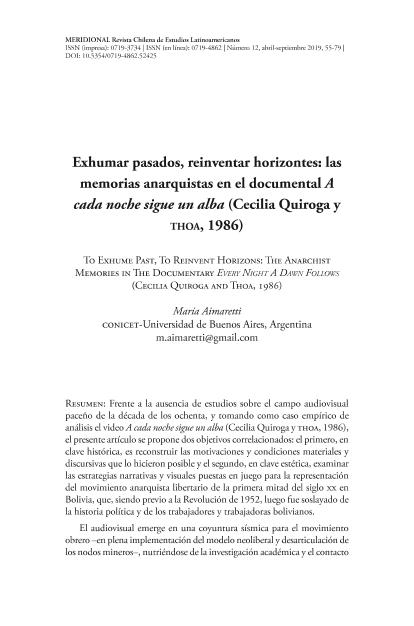Artículo
Frente a la ausencia de estudios sobre el campo audiovisual paceño de la década de los ochenta, y tomando como caso empírico de análisis el video A cada noche sigue un alba (Cecilia Quiroga y Thoa, 1986), el presente artículo se propone dos objetivos correlacionados: el primero, en clave histórica, es reconstruir las motivaciones y condiciones materiales y discursivas que lo hicieron posible y el segundo, en clave estética, examinar las estrategias narrativas y visuales puestas en juego para la representación del movimiento anarquista libertario de la primera mitad del siglo xx en Bolivia, que, siendo previo a la Revolución de 1952, luego fue soslayado de la historia política y de los trabajadores y trabajadoras bolivianos.El audiovisual emerge en una coyuntura sísmica para el movimiento obrero -en plena implementación del modelo neoliberal y desarticulación de los nodos mineros-, nutriéndose de la investigación académica y el contacto directo con organizaciones sindicales. Hecho por mujeres, se atreve rastrear y reunir testimonios desatendidos y experiencias de lucha dispersas que podrían renovar horizontes políticos e imaginarios, demarcándolos de la lógica hegemónica partidaria (MNR), sindical tradicional (COB)o patriarcal(mundo del trabajo=hombres). La opción por privilegiar esas otras memorias de la revuelta y la organización conlleva la audacia de repensar y representar "nuevos pasados" libertarios cuya fuerza y originalidad podrían reactualizarse en el presente de peligro. Facing with the absence of studies on the La Paz audiovisual field of the eighties; and taking as an empirical case of analysis the video Every Night Follows a Dawn (Cecilia Quiroga and thoa, 1986), this article proposes two correlated objectives: the first, in a historical key, is to reconstruct the motivations and material and discursive conditions that they made it possible, and the second, in an aesthetic key, to examine the narrative and visual strategies put into play for the representation of the libertarian anarchist movement of the first half of the 20th century in Bolivia, which, prior to the 1952 Revolution, was later ignored in political history and of the bolivian workers The audiovisual emerges in a seismic situation for the workers’ movement –in full implementation of the neoliberal model and dismantling of the mining nodes–, drawing on academic research and direct contact with trade union organizations. Made by women, it dares to trace and gather unattended testimonies and scattered experiences of struggle that could renew political and imaginary horizons, demarcating them from the hegemonic logic of the party (mnr), traditional union (cob) and/or patriarchal (world of work=men). The option of privileging those other memories of the revolt and the organization entails the audacity to rethink and represent “new pasts” libertarians whose strength and originality could be updated in the present of danger.
Exhumar pasados, reinventar horizontes: las memorias anarquistas en el documental A cada noche sigue un alba (Cecilia Quiroga y THOA, 1986)
Título:
To Exhume Past, To Reinvent Horizons: The Anarchist Memories in The Documentary Every Night A Dawn Follows (Cecilia Quiroga and Thoa, 1986)
Fecha de publicación:
27/02/2019
Editorial:
Universidad de Chile. Facultad de Filosofía y Humanidades. Centro de Estudios Culturales Latinoamericanos
Revista:
Meridional
ISSN:
0719-4862
Idioma:
Español
Tipo de recurso:
Artículo publicado
Clasificación temática:
Resumen
Palabras clave:
BOLIVIA
,
MEMORIA ANARQUISTA
,
CINE DOCUMENTAL
,
TESTIMONIO
Archivos asociados
Licencia
Identificadores
Colecciones
Articulos(SEDE CENTRAL)
Articulos de SEDE CENTRAL
Articulos de SEDE CENTRAL
Citación
Aimaretti, Maria Gabriela; Exhumar pasados, reinventar horizontes: las memorias anarquistas en el documental A cada noche sigue un alba (Cecilia Quiroga y THOA, 1986); Universidad de Chile. Facultad de Filosofía y Humanidades. Centro de Estudios Culturales Latinoamericanos; Meridional; 12; 27-2-2019; 55-79
Compartir
Altmétricas




